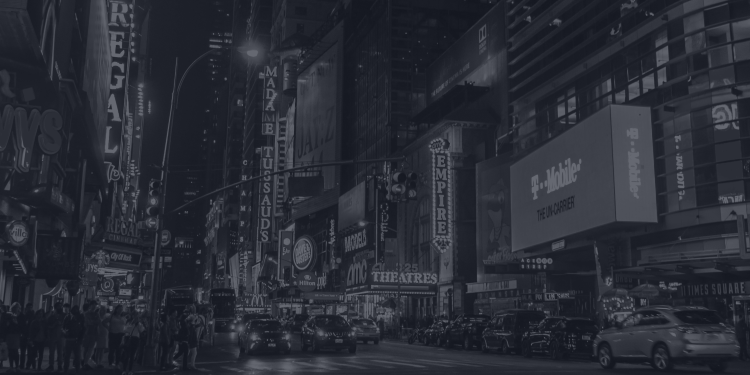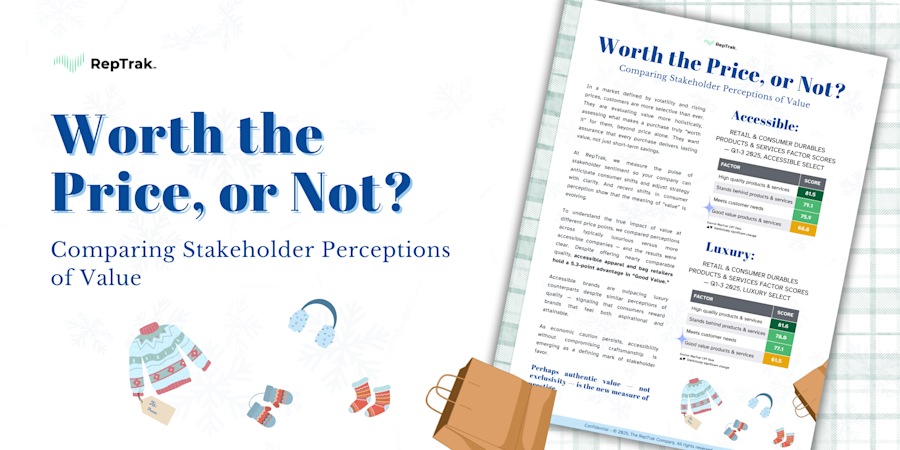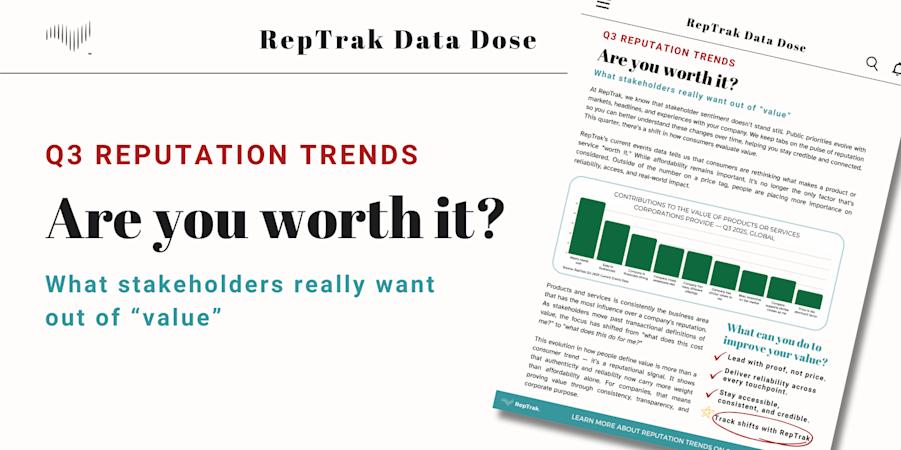What's In A Brand?
Blog Post28 Apr, 2022
Introduction
Companies can grow their reputations by taking advantage of a readily accessible asset – their brands. A brand is the "intended promise" a company makes to its stakeholders. It is 'inside-out': the company owns its narrative and self-defines its identity. Reputation is how a company fulfills its promise in the eyes of its stakeholders; therefore, it represents an 'outside-in' view of the enterprise – and this is the value of reputation, the external perspective. Ideally, a company's brand aligns with its reputation; in reality, its self-defined brand aspiration often diverges from its external reputation.
RepTrak examined the relationship between brand and reputation to better understand which measures of company expression most positively affect reputation. The result for corporates is closely aligned worldwide. While there are some regional nuances, most companies can be confident that activating these three components will deliver brand and reputation coherence:
Consistency – Meeting stakeholder needs in adherence to the company mission
Authenticity – Taking actions that present as genuine and sincere, not opportunistic
Uniqueness – Differentiating from peers and competitors
There is a close and complex relationship between reputation and brand. A strong corporate brand can help boost reputation, while reputation improvement spurs brand equity. High-performing companies can navigate this intersection – and recognize when to capitalize on making the most of this dynamic.
To do this we look at how specific companies have leveraged the brand-reputation relationship to deliver increased value to stakeholders and shareholders across three specific applications:
Mission Elevation: A brand shift based on a business transformation
Misconduct Maneuver: Rebranding following a crisis
One Versus Many: Comparing a house of brands with a branded house
Mission Elevation
Companies evolve their brand strategies when their mission no longer supports existing brand perceptions. In this case, a brand pivot brings to life what the company hopes to represent, and it intends to help it better align with its long-term goals and vision.
Prolonged brand misalignment can affect the bottom line. Fractured perceptions about a company's brand can negatively impact the economic value a company should derive from developing positive stakeholder perceptions, e.g. greater familiarity, obtaining loyal customers, having engaged employees, and securing partner relationships.[i] But companies can protect their business value by re-shaping brand identity when perceptions run off course.
CVS, originally named the Consumer Value Store, is an example of a company that experienced brand misalignment. By 2014, CVS Caremark Corporation was already a market-leading American retailer.[ii] It was at No. 12 on the Fortune 500 list that year, accompanied by a strong Reputation Score (73) and four well-established lines of business – food and drug retail stores, a pharmacy benefit management business, walk-in health clinics, and a growing specialty pharmacy business.[iii]
Despite the company's documented pursuit of healthcare and innovation, the general public primarily regarded CVS as a convenience store.[iv] So in early 2014, the organization announced a landmark decision to stop selling cigarettes and tobacco products in all 7,700 retail locations. In the announcement, CVS said "the sale of tobacco products is inconsistent with our purpose – helping people on their path to better health."[v]
The change was unprecedented at this scale, and it garnered significant news coverage across the U.S. But still, public misconceptions prevailed. Americans struggled to see the value in CVS as a healthcare services provider because of a deep-rooted perception problem – the public recognized CVS primarily as a retail stalwart. CVS needed to break from its image as a drugstore retailer – and into one that people recognized for its unwavering commitment to health and pharmacy innovation.[vi]
To do this, CVS launched a strategic corporate rebrand later in 2014 to clarify its message and cement its place in the health care sector. The business announced a name change from CVS Caremark to CVS Health, which coincided with the end of its tobacco sales. [vii] The rebrand sent a powerful and deliberate message to emphasize its broader commitment to health and wellness. CVS President and CEO Larry J. Merlo said: "Today, as CVS Health, we are tobacco-free, reinventing pharmacy and taking our place among leaders in the health care community."[viii]
Using a fresh rebrand that paired actions with words, the company created an opportunity to re-calibrate public perceptions. As the first U.S. pharmacy to ban tobacco products, CVS underscored its promise for good health and forged meaningful differentiation in the market.[ix] Most significantly, CVS firmly marked its vision and commitment to the healthcare space to escape its outdated corner store image.[x]
Rebrand Results:
Following the rebrand, CVS Health saw a 5.5% year-over-year bump in same-store sales and a 22% increase in pharmacy services revenue.
CVS's decision to remove tobacco products improved American public health. Loyal shoppers stood in solidarity and told CVS store teams, "When you quit, I quit." The decision translated into 100 million fewer cigarettes sold across the country and a 38% decline in shoppers' intent to buy tobacco.
CVS successfully held onto a strong Reputation Score for nearly a decade. Most notably, the corporation consistently outperformed both sectors it competed in: Retail and Healthcare. Today, CVS Health is RepTrak's second-highest scoring healthcare company – and it enjoys positive stakeholder support. As of Q4 2021, CVS Health has greater than 50% of advocates (strong supporters) Willing to Buy. High levels of stakeholder support are also evident for Recommend Products (44%) and Say Positive Things (42%).
How to Take Action:
Consider mission elevation. With a rebrand, companies must start from a values-based and mission-oriented perspective. This approach means analyzing the aspects of a brand that make it appealing and directly affect its reputation. It also means deliberate intent around how a company communicates its vision, crafts its public persona, and delivers value to its stakeholders. By appropriately identifying gaps, companies can adjust their positioning to represent their mission better.
Never waver on customer experience. RepTrak brand measurements show a strong correlation between Brand Expressiveness – how the public perceives what a company says and does – with Reputation Scores and Business Outcomes. One brand measure, "Delivers a consistent experience," is consistently at the fore. It is the second most crucial brand measurement that correlates with Reputation Scores in the Americas, EMEA, and APAC regions. It also directly affects the bottom line: The public is most "Willing to buy" from companies that can deliver on consistency.
Reliability will pay reputation dividends. Stakeholders have clear expectations for reliability. A strategic rebrand can follow a substantial business transformation, but the "new" brand must still fulfill its "old" promise amid the growing pains. "Delivering a consistent experience" sounds amorphous. However, companies can activate against this through the Products Driver and related Factors such as providing high-quality, good value, and meeting stakeholder needs. The key to boosting public favor is tying the brand's evolution to its continued service offering and overall mission. This is how to meet expectations.
Misconduct Maneuver
Corporate rebranding is also a popular tool to sidestep controversy. Time and again, reputation-challenged businesses hope to escape negative publicity by simply changing their name. Many fail to realize that a new name is not enough for a full reputation reset. Companies must go beyond new names, trendy icons, and updated logos to persuade audiences that their values have changed.
Demonstrating authentic sincerity in a way that resonates with the public can take time – and can be an uphill battle for companies. This undertaking is even more challenging when mature companies must overcome a long history of negative publicity. One company such company that has been fraught with such scandal in recent years is Facebook.
The world's most used social media platform has captured users for over 18 years.[xiii] In 2012, Facebook was the largest technology IPO in U.S. history, valued at $106 billion, and its market value has since skyrocketed, starting in 2022 with a market capitalization close to $1 trillion.[xiv] Yet, despite the social media giant's tremendous financial success, Facebook's reputation has not kept pace.
Its IPO aura was short-lived. Four years later, Facebook faced one controversy after another. In turn, the company's global Reputation Score was hit hard. Between 2016 and 2018 alone, the tech giant faced content censorship challenges, regulatory investigations, and a significant misinformation problem, which all played out on the public stage.[xv] Months turned into years of steady turmoil that weakened its global average Reputation Score by five points; so much that by the start of 2018, its global Reputation Score was teetering on the edge of "poor" (60.5)[xvi]
Then in March 2018, Facebook confronted arguably the most significant scandal of its history: Cambridge Analytica, a British consulting firm, illegally accessed 80 million Facebook users' personal information to influence the 2016 U.S. presidential election.[xvii] After U.S. and EU government hearings on Facebook's user privacy regulations and a separate, large security breach in the months that followed, Facebook's reputation plunged another 6.2-points, lowering its average Reputation Score to 54.2.[xviii]
In 2020 and 2021, an additional set of challenging issues that turned into national headlines accompanied Facebook's downward reputation trends and regulatory threats. Platform outages, advertising partner boycotts, involvement in the Jan. 6 U.S. Capitol Riot, censorship controversy, and whistleblower allegations were just a few of the scandals affecting the company's brand, name, and reputation.
When Facebook announced a new corporate rebrand was underway – public opinion was already extremely low. In October 2021, CEO Mark Zuckerberg announced the firm was transitioning to Meta Platforms Inc. (Meta) and, in doing so, closing a metaphorical door to its past by placing Facebook's future in the virtual world – the metaverse. While the rebrand announcement highlighted new efforts to "bring together apps and technologies under one company brand" and focused on "bringing the metaverse to life," – it wasn't enough to instantly shed Facebook's old reputation.[xix]
Repeated misconduct presents a significant public perception hurdle for companies to overcome. Not yet one year into the Meta rebrand it is clear so far that the effort to create fresh energy and new perceptions with 'Meta' will take time and also more meaningful actions to regain stakeholder trust.
Rebrand Results:
Before the formal announcement of Meta, Facebook's Reputation Score was at a weak 48.5 in Q3 2021.
Not long after, the Wall Street Journal's investigative series "Facebook Files" revealed accounts of toxic behavior and user misguidance – which brought multiple government hearings around the world at the end of 2021. After declaring its new brand, the company's overall reputation dropped nearly 3-points to 45.6 in Q4 2021. Early 2022 results indicate the same, with a weak score of 45.8.
Meta's new brand does not automatically guarantee it a new reputation. Its legacy reputation lingers. Its dwindling public license to operate threatens the company's significant ambitions. During the period of the rebrand – Q1 2021 and Q1 2022 – essential indicators of stakeholder support are down. Most notably, "Trust" is down by 5% among advocates year over year, "Say Positive Things About" is down by 3%, and "Benefit of the Doubt" nets 0% change. Facebook advocates across the board are very low with support averaging 15% across all Business Outcomes.
Brand Expressiveness measure "Appears genuine for what it stands for" are at all-time lows for the company throughout 2021. In Q4 2021, advocates declined two percentage points immediately after the rebrand and averaged a low-scoring 17% for the quarter.
How to Take Action:
Deliver authenticity. 'Brand' is an intended promise companies make; inauthentic positioning jeopardizes that promise. When a company cannot deliver, it risks outright reputation harm and adverse effects on Business Outcomes.
The public has solid and positive-leaning sentiments toward authenticity and genuine expression. RepTrak data shows one brand expression measure that ties closely to reputation: "Appears genuine in what it says and stands for." It is the top measurement that shapes reputation around the world, and it has the strongest correlation to two Business outcomes; "Trust" and "Benefit of the doubt."
Corporates must demonstrate that their brand changes are more than surface-level. Today, consumers are savvy and expect reliable evidence before they believe a company has changed – 90% of customers mentioned authenticity as an essential consideration when deciding which brands to support.[xx] Brand changes are more credible and sincere when the shift is part of a broader strategy than an instinctual reaction. The onus is on corporations to demonstrate that brand changes in light of bad press are more than just on the surface.
One Versus Many
Brand architecture directly relates to reputation. The strategy a company uses can affect how stakeholders conceptualize the organization, its offerings, and the story it tells. Here, reputation can be a leading indicator of whether a company has appeal, visibility, and the perception-market fit it desires.
Companies must determine if there are greater reputation benefits from associating brands with a parent organization or from standalone brands. Brand architecture – the organizational structure of a company's portfolio of brands and sub-brands – is deployed as a strategic consideration.
Building on this structure, two concepts need definition – house of brands and branded house.
A branded house has a strong "master brand" with sub-brands or divisions that feature critical products and corporate elements or share names with the master brand.
A house of brands is a collection of unique, independent brands under a "parent brand" that is often less well-known than its product brands.
Both models have benefits and drawbacks depending on the organization's purpose and general go-to-market strategy, and a combination of the two types creates a distinctive hybrid structure.
One: Branded House
Branded house architecture aligns all products and services under one brand name. It can allow for efficient marketing and a streamlined value proposition. Uniting a product suite under a single name, logo, and voice can ultimately amplify the company persona. A branded house is a more traditional model; the corporate brand is the same as the consumer brand. Companies such as Google, Apple, Harley-Davidson, and FedEx are well-known for establishing a single strong corporate-to-product brand.
What do the reputations of widely recognized branded houses have in common? RepTrak measured the companies mentioned above and found that they share two distinct characteristics. First, they all have strong (70>) or excellent (80>) Brand Scores. Secondly, regardless of industry, the public strongly supports these companies across two Brand Expression measures: "Stands out from the crowd" and "Delivers a consistent experience."
Companies that fulfill these two attributes can consider using the branded house model to build on a known standard. The advantages here enable a company to have a head start in reputation and carry specific public perceptions of company uniqueness and reliability. All products, services, and subsequent offerings for branded house companies carry the brand's halo effect. While this is beneficial, it also comes with drawbacks – if the branded house is compromised, its satellite products and brands will suffer.
Many: House of Brands
Building brand association for a house of brands can lead to powerful results. Reputation and Business Outcomes can improve for a parent company as public awareness of its brand portfolio increases.
P&G, the American multinational company, is an example of where the specific association with a parent brand substantially improved its Reputation Score and Business Outcomes. The company ran brand campaigns during the Olympics prominently featuring its logo to ensure it raised awareness for its entire portfolio of brands.
Reputation Results
P&G's association with brands improved by 7% following the campaign. Additionally, there appears to be a leverage effect as the number of brand associations increases so too does its Reputation Score:
When the public associated more brands with P&G, P&G's Reputation Score improved substantially due to awareness of its brand portfolio. When there were no associated brands, P&G's score was average at 67.9. By just having one or two brands linked to the parent company, its Reputation Score increased to 75.9. It moved into the excellent range with three or more brands, exceeding an "excellent" score of 80.
The proportion of those who preferred P&G's products improved from 41% to more than 60%
The proportion of those who had corresponding trust improved from 68% to upwards of 88%
The proportion of those open to purchasing P&G's products jumped from 48% to above 79%
How to Take Action:
Blend or Build: Companies must decide which brand architecture to pursue based on their inherent attributes and desired reputation outcomes.
A house of brands model is advantageous for companies with an existing brand portfolio. Here, companies with a "master brand" can use its influence to garner public recognition for their sub-brands and vice-versa, like in the case of P&G. Ultimately, this feedback-to-perception loop strengthens both reputation positions across the portfolio, creating awareness of all affiliations.
Companies with a unique selling point can build their reputation using the branded house model. This standard is best for familiar brands that have earned consumers' trust and recognition for consistent and outstanding products and services. With a solid foundation, the company can evolve future offerings and products.
This report uses global data from RepTrak’s continuous and annual data sets.
[i] RepTrak Study: The Joint Impact of Reputation & Brand on Stakeholder Support, 2014
[iii] CVS Rebrands as CVS Health, Takes Next Steps to Making America Tobacco-Free
[iv] Heart of the matter: Shaping the future of health care with purpose-led branding
[v] CVS Quits: A message from Larry Merlo, President and CEO
[vii] CVS: Our history and 2016 REBRAND 100: distinction and CVS Caremark Announces Corporate Name Change to CVS Health to Reflect Broader Health Care Commitment
[viii] CVS Caremark Announces Corporate Name Change to CVS Health to Reflect Broader Health Care Commitment
[ix] What to Learn from the CVS Rebranding Case Study
[x] How quitting tobacco reshaped CVS: Q&A with CEO Larry Merlo
[xi] Heart of the matter: Shaping the future of health care with purpose-led branding
[xii] How quitting tobacco reshaped CVS: Q&A with CEO Larry Merlo and After CVS Stopped Cigarette Sales, Smokers Stopped Buying Elsewhere, Too
[xiii] Digital 2022 Global Overview Report
[xiv] Facebook Faces An ‘Existential Moment’ After $230 Billion Stock Crash
[xv] 2016: the year Facebook became the bad guy
[xvi] "I Care Deeply About the Democratic Process" Mark Zuckerberg Reveals Facebook Election Meddling Plan
[xvii] Facebook and Cambridge Analytica: What You Need to Know as Fallout Widens
[xviii] Social media hearings: Sheryl Sandberg says Facebook was too slow to respond to Russia election interference and Mark Zuckerberg to Meet European Parliament Members Over Facebook’s Data Use






